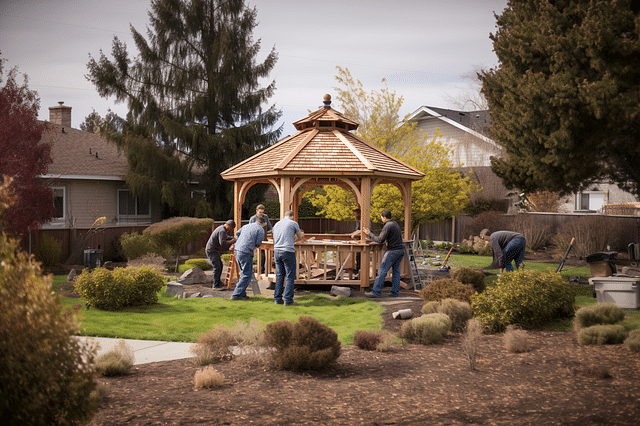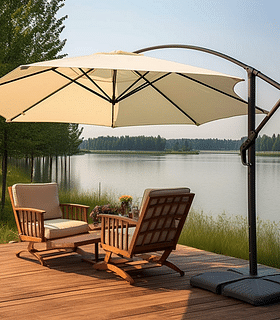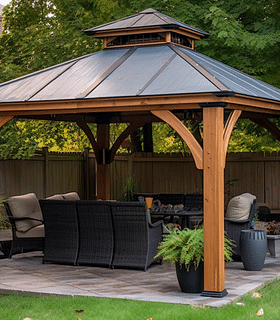How to Safely Move a Gazebo Without Any Hassle
Discover the foolproof method to safely move a gazebo without any hassle. Our step-by-step guide will show you how to relocate a gazebo without causing any damage to it or your yard. Don't let the stress of moving a gazebo deter you anymore. Start your relocation process today!

Do you have a beautiful gazebo in your backyard that you're dying to move to a new location? Perhaps you're rearranging your outdoor space, or maybe you're moving to a new house and want to take your gazebo with you. Whatever the reason may be, moving a gazebo can seem like a daunting task. After all, gazebos are heavy and delicate structures that require careful handling. But fear not! In this blog post, we're going to show you exactly how to safely move a gazebo without any hassle. We'll guide you through the entire process, step by step, so you can confidently relocate your gazebo to its new home. So grab your tool belt and let's get started!
Assessing Your Gazebo and Yard
When it comes to setting up a gazebo in your yard, there are a few key factors to consider. In this section, we will discuss how to assess your gazebo and yard to ensure the best possible setup.
Is your gazebo portable?
The first thing you'll want to determine is whether your gazebo is portable or not. Some gazebos are designed to be easily moved and relocated, while others are more permanent structures. If your gazebo is portable, you'll have more flexibility in choosing the ideal location in your yard.
Portable gazebos are typically lightweight and can be disassembled and assembled easily. They often come with a carrying case or bag for convenient transportation. So, if you plan on hosting outdoor events in different areas of your yard or even taking your gazebo to the park or beach, a portable option might be the best choice for you.
On the other hand, if your gazebo is a more permanent fixture in your yard, you'll need to carefully consider the location where it will be installed. Permanent gazebos are usually heavier and require a more stable foundation. They are designed to withstand all weather conditions and provide a durable outdoor gathering space.
Evaluating the destination
Once you've determined whether your gazebo is portable or not, it's time to evaluate the destination where you plan to set it up. Take a walk around your yard and consider the following factors:
Sun Exposure: Pay attention to the path of the sun throughout the day. You'll want to choose a location that provides the desired amount of shade or sunlight, depending on your preference. Keep in mind that the angle of the sun changes throughout the year, so consider the seasonal variations as well.
Wind Direction: Take note of the prevailing wind direction in your yard. You'll want to position your gazebo in a way that provides a comfortable and sheltered space for your guests. Avoid areas where strong winds can cause discomfort or even damage to the gazebo.
Terrain: Consider the terrain and topography of your yard. Is the ground level or sloping? Uneven ground can make it challenging to set up a gazebo, especially if it requires a flat surface. If your yard has slopes or irregularities, you may need to do some leveling or consider using a platform for the gazebo.
Access and Visibility: Think about how your guests will access the gazebo and how visible it will be from the main areas of your yard. You'll want to place it in a convenient location that enhances the overall aesthetic and functionality of your outdoor space.
By carefully assessing your gazebo and yard, you can choose the best location for your gazebo that maximizes its potential and creates a welcoming and enjoyable outdoor oasis.
Preparing Your Gazebo for Moving
Moving a gazebo may seem like a daunting task, but with proper preparation, it can be a smooth and hassle-free process. In this section, we will cover the essential steps to ensure your gazebo is ready for the move.
Clearing the area
Before you begin moving your gazebo, it's important to clear the area surrounding it. Remove any furniture, planters, or other objects that may obstruct the path or pose a safety hazard during the moving process. This will provide a clear pathway and prevent any potential damage to your gazebo or surrounding area.
Detaching any accessories
Next, take some time to detach any accessories that are attached to your gazebo. This includes things like screens, curtains, lights, or any other decorative elements. Carefully remove these accessories and set them aside in a safe place. Detaching these items will not only make the gazebo lighter and easier to move but also prevent any damage that may occur during the transportation process.
Disassembling the gazebo (if necessary)
If your gazebo is designed to be disassembled, it is highly recommended to do so before moving it. Check the assembly instructions or manufacturer's guidelines to determine the proper steps for disassembly. Start by removing the roof, followed by the walls and support beams if applicable. Take care to label and organize each piece to make reassembly at the new location a breeze.
Disassembling your gazebo not only makes it more manageable for transport, but it can also prevent any potential damage that may occur during the move. Additionally, disassembling the gazebo will allow you to inspect each component, making it easier to identify and address any necessary repairs or maintenance before reinstallation.
By following these steps and properly preparing your gazebo for the move, you can ensure a seamless transition to its new location. Remember to take your time and exercise caution during the process to avoid any damage or injuries.
Gathering the Right Tools and Equipment
Before you embark on any project, it's essential to gather the right tools and equipment to ensure a smooth and successful outcome. In this section, we'll discuss two important aspects: understanding what you'll need and deciding whether to rent or purchase the necessary equipment.
Understanding what you'll need
To start off, you need to have a clear understanding of the tools and equipment required for your project. It's essential to be prepared and have everything you need on hand to avoid unnecessary delays or complications. Here are a few steps to help you identify the tools and equipment you'll need:
Research your project: Take the time to research and understand the specific requirements of your project. This will give you a clear idea of the tools and equipment needed.
Make a checklist: Create a checklist of all the tools and equipment you'll need. Be thorough and consider every aspect of the project. If you're unsure about any items, consult with experts or professionals in the field.
Consider safety: Don't forget about safety equipment. Depending on your project, you may need items such as safety goggles, gloves, helmets, or harnesses. Always prioritize safety and include the necessary gear on your checklist.
Once you have a comprehensive checklist, you can move on to the next step: deciding whether to rent or purchase the necessary equipment.
Renting or purchasing the necessary equipment
When it comes to acquiring the required tools and equipment, you have two options: renting or purchasing. Each option has its advantages and considerations. Let's take a closer look at each:
Renting equipment: Renting can be a cost-effective solution, especially if you don't plan to use the equipment frequently or for long-term projects. Renting allows you to access high-quality tools and equipment without the upfront cost of purchasing. Additionally, rental companies often provide maintenance and support for their equipment.
Purchasing equipment: If you foresee using the tools and equipment on a regular basis or for long-term projects, purchasing might be a more practical option. While it involves upfront costs, owning the equipment provides convenience and flexibility. You have the tools readily available whenever you need them, without the constraints of rental agreements or potential unavailability.
When deciding whether to rent or purchase, consider factors such as the duration of your project, your budget, the frequency of tool usage, and storage space. It's also worth comparing rental costs to the price of purchasing to determine the most cost-effective option for your specific needs.
By understanding what you'll need and considering whether to rent or purchase, you can ensure that you have the right tools and equipment for your project. This preparation will allow you to work efficiently and effectively, ultimately leading to a successful outcome.
Moving your Gazebo to its new location

Moving your gazebo to a new location doesn't have to be a daunting task. With a little bit of preparation and careful execution, you can safely transport your gazebo and enjoy it in its new spot. In this step-by-step guide, we will walk you through the process of moving your gazebo from start to finish.
Step 1: Preparing the gazebo for transportation
Before you begin the actual moving process, it's important to properly prepare your gazebo for transportation. Here are a few key steps to follow:
Remove any accessories or loose items: Start by removing any accessories or loose items from your gazebo, such as cushions, curtains, or decorations. These items should be safely stored and transported separately to avoid damage.
Secure loose parts: Make sure to secure any loose parts of the gazebo, such as the roof or panels, to prevent them from getting damaged during transportation. You can use zip ties or bungee cords to keep everything in place.
Inspect for any damage: Take a close look at your gazebo and inspect it for any existing damage or weak spots. Repair any issues before moving the gazebo to ensure its structural integrity.
Measure the gazebo dimensions: Measure the dimensions of your gazebo, including its height, width, and length. This will help you determine the best way to transport it and ensure that it will fit through any doorways or openings.
Step 2: Disassembling the gazebo (if necessary)
If your gazebo is not designed to be easily moved as a whole unit, you may need to disassemble it before transportation. Here's how to do it:
Consult the manufacturer's instructions: Check the manufacturer's instructions or guidelines for disassembling your specific type of gazebo. This will ensure that you follow the correct steps and don't damage any components.
Start with the roof: Begin by removing the roof panels or canopy. Carefully detach them from the frame, taking note of how they are connected for easy reassembly later.
Remove the walls or side panels: If your gazebo has walls or side panels, remove them next. Again, pay attention to how they are attached and store them safely to avoid any damage.
Take apart the frame: Finally, disassemble the frame of the gazebo, starting from the top down. Carefully remove each section and label or mark them if needed for reassembly.
Step 3: Moving the gazebo
Now that your gazebo is prepared and, if necessary, disassembled, it's time to move it to its new location. Follow these steps for a smooth and successful relocation:
Gather a team of helpers: Moving a gazebo requires manpower, so gather a team of friends or family members to assist you. Make sure everyone understands their roles and the importance of communication during the process.
Use proper lifting techniques: When lifting and carrying the gazebo sections, use proper lifting techniques to avoid injuries. Bend at your knees, keep your back straight, and lift with your legs rather than your back.
Utilize equipment and tools: Depending on the size and weight of your gazebo, you may need some equipment or tools to aid in the moving process. This can include dollies, hand trucks, or straps to secure the sections during transportation.
Take it slow and steady: Moving a gazebo requires patience and careful movements. Take your time, especially when navigating tight spaces or doorways, to prevent any damages or accidents.
Step 4: Reassembling the gazebo
Once you have safely transported your gazebo to its new location, it's time to reassemble it. Follow these steps to ensure a successful reassembly:
Consult the manufacturer's instructions: Refer back to the manufacturer's instructions or guidelines for reassembling your gazebo. This will ensure that you follow the correct steps and don't miss any important details.
Start with the frame: Begin by assembling the frame of the gazebo, following the reverse order of the disassembly process. Use any labels or markings you made during the disassembly to guide you.
Attach the walls or side panels: If applicable, attach the walls or side panels to the frame. Make sure they are secured properly and aligned correctly.
Install the roof panels or canopy: Finish the reassembly process by attaching the roof panels or canopy to the gazebo frame. Ensure that they are securely fastened and in the correct position.
By following these steps, you can successfully move your gazebo to a new location without any hassle.
Ensuring Safety and Avoiding Damage
When it comes to your new gazebo, safety and avoiding damage are key concerns. Whether you're transporting the gazebo or setting it up in your yard, taking the right precautions can help protect both the gazebo itself and your surroundings. In this section, we'll discuss how to protect the gazebo during transportation and how to avoid any damage to your yard.
Protecting the gazebo during transportation
Transporting a gazebo from one location to another requires careful handling to prevent any potential damage. Here are a few tips to ensure the safety of your gazebo during transportation:
Secure the parts: Before you transport your gazebo, make sure to secure all the parts properly. This includes removing any loose panels or detachable accessories and securing them separately. Use zip ties or bungee cords to hold the parts together.
Cover the gazebo: It's a good idea to cover the gazebo with a protective tarp or tarpaulin during transportation. This will provide an extra layer of protection against dust, dirt, and possible scratches.
Use proper padding: To prevent any potential damage during transportation, consider using padding materials such as foam or bubble wrap to cushion the gazebo parts. This will help absorb any shocks or vibrations that may occur while on the move.
Secure the gazebo: When loading the gazebo onto a truck or trailer, make sure it is secured firmly. Use straps or ropes to secure the gazebo to prevent any movement or shifting during transportation. This will help avoid any unnecessary stress on the structure.
With these tips in mind, you can transport your gazebo safely and ensure it arrives at its new location without any damage or issues.
Avoiding damage to your yard
When setting up your gazebo in your yard, it's important to take precautions to avoid any damage to the surrounding area. Here are some helpful tips:
Choose the location wisely: Before setting up your gazebo, carefully choose the location in your yard. Look for a flat and level surface that can easily accommodate the size of your gazebo. Avoid areas with slopes or uneven ground that could cause instability or damage.
Clear the area: Ensure that the area where you plan to set up the gazebo is clear of any obstacles, such as rocks, tree roots, or garden decorations. Clearing the area will prevent any tripping hazards and ensure a smooth and safe setup.
Use proper anchoring: Once your gazebo is set up, it's important to properly anchor it to the ground. This will provide stability and prevent it from getting uprooted or blown away in strong winds. Use anchoring systems such as ground stakes, weights, or concrete footings to secure the gazebo firmly.
Protect the grass: If you're setting up your gazebo on a grassy area, take measures to protect the grass underneath. Avoid leaving the gazebo set up in one location for an extended period, as it can cause the grass to wilt or die. Consider moving the gazebo periodically or using protective platforms or pavers underneath to distribute the weight evenly and prevent grass damage.
By following these guidelines, you can enjoy your gazebo without worrying about any potential damage to your yard or surroundings.
Troubleshooting and Common Challenges
Moving a gazebo can sometimes present challenges that you may not have anticipated. In this section, we will discuss some common problems that people encounter during a gazebo move and provide guidance on what to do if you encounter unexpected obstacles.
Common problems encountered during a gazebo move
Uneven or unstable ground: One of the common challenges when moving a gazebo is dealing with uneven or unstable ground. This can make it difficult to properly position and level the gazebo in its new location. To address this, consider using shims or leveling tools to ensure stability and proper balance.
Weather conditions: Another issue that can arise during a gazebo move is unfavorable weather conditions. Rain, strong winds, or extreme temperatures can make the process more challenging and potentially damage the gazebo. It's important to monitor the weather forecast and plan your move accordingly. If the weather is not cooperating, it may be best to postpone the move to a more suitable time.
Disassembling and reassembling: Taking apart and reassembling a gazebo can be a time-consuming and complex process. Screws and bolts may be difficult to remove, and you may encounter missing or damaged parts. It is essential to carefully label each component during disassembly to make reassembly easier. If you face challenges during the process, you may want to consult the gazebo's instruction manual or seek professional help.
Transportation: Proper transportation of a gazebo is crucial to prevent damage. If you are moving the gazebo yourself, it's important to secure it properly on a suitable vehicle. Ensure that all parts are securely fastened to prevent them from moving or getting damaged during transit. If you are unsure about how to transport your gazebo safely, consider consulting a professional moving company.
Hiring Professional Help or Going the DIY Route

Moving can be a daunting task, and you may find yourself wondering whether to hire professional movers or tackle the move yourself. In this section, we will explore the pros and cons of both options to help you make an informed decision.
Weighing the Pros and Cons of Professional Movers
Pros of Hiring Professional Movers
- Convenience: Professional movers handle the entire moving process, from packing to unpacking, saving you time and effort.
- Experience and Expertise: They have the skills and knowledge needed to handle fragile items, heavy furniture, and navigate tricky logistics.
- Equipment and Resources: Professional movers come equipped with the necessary tools, equipment, and packing supplies to ensure a smooth and efficient move.
- Insurance: Reputable moving companies offer insurance coverage for your belongings, providing peace of mind in case of any damages or losses.
Cons of Hiring Professional Movers
- Cost: Hiring professional movers can be more expensive compared to a DIY move, especially for long-distance or large-scale moves.
- Less Control: When you hire movers, you relinquish some control over the moving process and have to rely on their schedule and methods.
Should You Attempt Moving the Gazebo by Yourself?
Moving a gazebo requires careful planning and execution. Here are a few things to consider before deciding to move it on your own:
Assess the Complexity and Size of the Gazebo
Moving a small, lightweight gazebo may be manageable for a DIY move. However, larger and more intricate structures may require professional assistance.
Check for Permits and Regulations
Depending on the location and size of the gazebo, you may need to obtain permits or adhere to certain regulations. Research the local requirements before attempting to move the gazebo yourself.
Consider Safety Precautions
Moving a gazebo can be physically demanding and potentially dangerous. It often involves disassembling and reassembling various parts, as well as lifting heavy materials. Ensure you have the necessary tools and equipment, and take safety precautions to avoid injuries.
Evaluate Your DIY Skills and Resources
Moving a gazebo requires some level of technical skill and the right tools. If you have experience with similar projects and access to the proper equipment, a DIY move may be feasible. Otherwise, hiring professionals is highly recommended.
Taking all these factors into consideration will help you decide whether to hire professional movers or take on the task of moving the gazebo yourself. Remember, prioritizing safety and ensuring a successful move should be your top concerns.
Trending products
Shop outdoor accessoriesFrequently asked questions
- Why should I move a gazebo?
- There are many reasons why you might need to move a gazebo, such as remodeling your yard or relocating to a new home. Moving a gazebo allows you to change its placement or take it with you to your new location.
- Can I move a gazebo on my own?
- Yes, you can move a gazebo on your own by following proper techniques and using the right tools. However, it is always recommended to have assistance when moving a larger gazebo to ensure safety and avoid any accidents.
- What tools will I need to move a gazebo?
- To move a gazebo, you will need basic tools such as screwdrivers, wrenches, a saw, and a heavy-duty dolly or cart. Depending on the gazebo's size and weight, you may also need additional equipment like straps or ropes.
- How do I prepare my gazebo for relocation?
- Before moving your gazebo, it is important to remove any loose or detachable parts, such as screens or curtains, and store them safely. Additionally, securing the gazebo's roof and panels can help prevent any damage during transportation.
- Do I need a permit to move a gazebo?
- The need for a permit to move a gazebo may vary depending on your local regulations. It is recommended to contact your local government or homeowner's association to inquire about any necessary permits or restrictions before moving your gazebo.
- How do I lift and transport a gazebo?
- To lift and transport a gazebo, you will need to carefully disassemble it into manageable sections. Using a dolly or cart, transport each section to the desired location, ensuring to secure them properly to prevent any shifting or damage.
- What precautions should I take when moving a gazebo?
- When moving a gazebo, it is important to protect yourself and others from potential injuries. Wear appropriate safety gear, use proper lifting techniques, and ensure there are no obstacles in the relocation path to minimize accidents.
- How can I prevent damage to my gazebo when moving it?
- To prevent damage to your gazebo, take extra care when handling and transporting each section. Use padding or moving blankets to cushion any fragile or exposed parts and secure them tightly to minimize movement during transportation.
- Can I hire professionals to move my gazebo?
- Yes, if you prefer not to move the gazebo yourself or if it is too large or delicate, hiring professionals experienced in gazebo relocation is a good option. They will have the necessary expertise and equipment to ensure a successful and hassle-free move.
- How long does it take to move a gazebo?
- The time it takes to move a gazebo can vary depending on its size, complexity, and the distance it needs to be relocated. In general, you should allocate a few hours or even a full day to properly disassemble, transport, and reassemble the gazebo at the new location.
Are you looking for more ideas?
Have a look at these other guides about improving your garden and patio to create your dream outdoor space!

Are you looking for more ideas?
-
- Role
- Outdoor Bar Sets for a Posh Garden Party
- Description
- Get ready to elevate your garden parties with outdoor bar sets for a posh and unforgettable experience. Find the perfect bar set that will turn your outdoor entertaining into a true sensation.
-
- Role
- How to effectively keep birds out of your gazebo
- Description
- Don't let annoying birds disrupt your gazebo bliss! Discover the best strategies and expert tips to keep birds out of your gazebo and protect your peaceful haven.
-
- Role
- What to put under your inflatable hot tub? - Top Tips!
- Description
- Discover the ultimate guide to choosing the perfect base for your inflatable hot tub. Get expert tips on what to put under your hot tub for maximum comfort and stability.
-
- Role
- How to properly anchor a gazebo to pavers
- Description
- Anchor your gazebo to pavers with ease! Follow our step-by-step guide on how to properly anchor a gazebo to pavers for a secure and sturdy outdoor structure. Never worry about strong winds or unstable ground again. Get started today!



